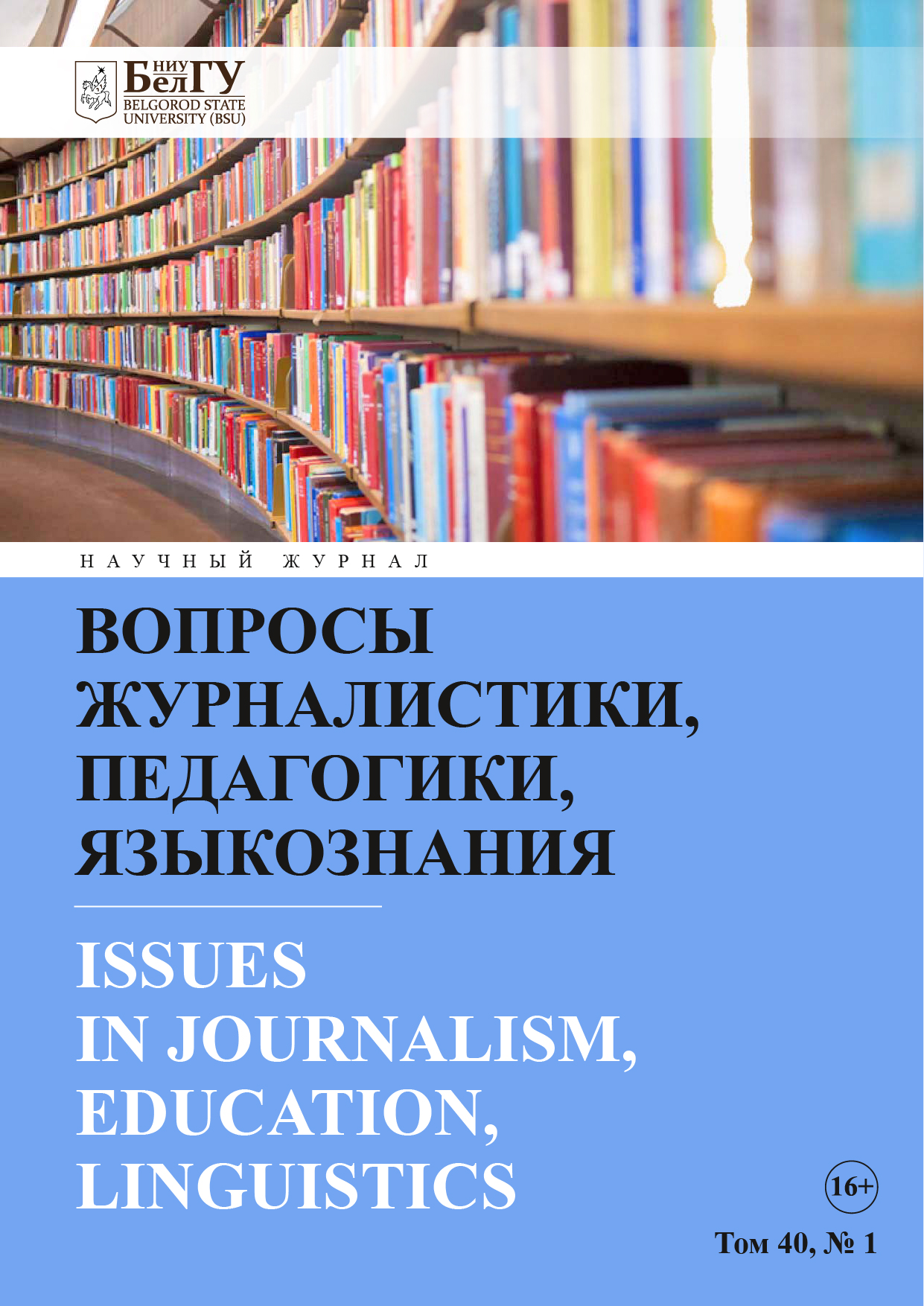Linguistic complexity of academic texts
Keywords:
academic text, linguistic complexity of text, readability, narrativity, lexical diversityAbstract
This study presents an innovative algorithm validated mechanism for assessing linguistic complexity of academic texts and is based on the system of linguistic parameters of schoolbook texts. The materials employed for the study are five texts from 6th grade textbooks in biology, recommended for use in secondary schools of the Russian Federation. The study was conducted in three main stages: identification of structural components of academic text; reconstruction of denotation maps; assessment of linguistic complexity of academic text using the parameters of readability (FKGL), narrativity, abstractness, lexical diversity (TTR). Spearman analysis indicated strong correlation between abstractness and lexical diversity, which implies that five linguistic parameters (length of sentences, words, readability index, abstractness/TTR and narrativity) suffice to conduct a full linguistic expertise provided that structural and denonative assessments are also pursued. The results of the study showed significant differences in the complexity of the texts ranging from the 6th to the 9th grades which can be used for different categories of recipients. The findings can also be employed in conducting language assessment of texts suitability for different categories of readers.
References
National Governors Association Center for Best Practices (NGA) and Council of Chief State School Officers (CCSSO). 2010. Common Core State Standards for English Language Arts and Literacy for History/Social Studies, Science, and Technical Subjects: Appendix A. Washington, 43 р. Available at: http://www.corestandards. org/assets/Appendix_A.pdf (accessed: 01 March 2021).
The Government of the Hong Kong Special Administrative Region. Education Bureau. 2016. Guiding Principles for Quality Textbooks. Electronic resource. Available at: https://www.edb.gov.hk/en/curriculum-development/resource-support/textbookinfo/GuidingPrinciples/index.html (accessed: 01 March 2021).
United Nations Educational, Scientific and Cultural Organization. 2014. Textbooks and learning resources: guidelines for developers and users. Paris, 24 р. Electronic resource. Available at: https://unesdoc.unesco.org/ark:/48223/pf0000226135_eng (accessed: 01 March 2021).
Микк Я.А. 1981. Оптимизация сложности учебного текста: в помощь авторам и редакторам. М., Просвещение, 119 с.
Пасечник В.В. 2016. Биология. Бактерии, грибы, растения. 6 класс. М., Дрофа, 141 с.
Пасечник В.В., Суматохин С.В., Калинова Г.С. 2010. Биология. 6 класс. М., Просвещение, 127 с.
Пасечник В.В., Суматохин С.В., Калинова Г.С., Гапонюк З.Г. 2014. Биология. 5–6 классы. М., Просвещение, 160 с.
Сухорукова Л.Н., Кучменко В.С., Колесникова И.Я. 2013. Биология. Живой организм. 5–6 классы. М., Просвещение, 143 с.
Трайтак Д.И., Трайтак Н.Д. 2013. Биология. Растения. Бактерии. Грибы. Лишайники. 5–6 классы. В 2-х ч. Ч. 1. М., Мнемозина, 136 с.
Болдина Н.А., Борисова Т.С. 2009. Гигиенические требования к учебнику и чтению. Минск, БГМУ, 34 с.
Бондаренко С.М. 1975. Почему детям трудно учиться. М., Знание, 64 с.
Валгина Н.С. 2003. Теория текста. М., Логос, 173 с.
Зуев Д.Д. 1974. Проблемы структуры школьного учебника. В кн.: Проблемы школьного учебника. Под ред. Ф. П. Коровкина и др. Вып.1. М., Просвещение: 28–46.
Криони Н.К., Никин А.Д., Филиппова А.В. 2008. Автоматизированная система анализа сложности учебных текстов. Вестник Уфимского государственного авиационного технического университета, 11(1): 101–107.
Мацковский М.С. 1976. Проблемы читабельности печатного материала. В кн.: Сорокин Ю.А., Шахнарович А.М. Смысловое восприятие речевого сообщения в условиях массовой коммуникации. Под ред. А.А. Леонтьева, Т.М. Дридзе. М., Наука: 126–142.
Новиков А.И. 1983. Семантика текста и ее формализация. М., Наука, 215 с.
Пономарева И.Н. 2012. Школьный учебник как система целей и содержания биологического образования. В кн.: Современные проблемы естественнонаучного образования. Материалы V Всероссийской (с международным участием) научно-методическая конференция учителей, преподавателей, студентов, магистрантов и аспирантов дисциплин естественнонаучного цикла, Красноярск, 13–15 ноября 2012 г. Красноярск, КГПУ: 11–15.
Рябушкина В.А. 2018. Использование денотатных карт учебных текстов при выборе УМК по английскому языку. Наука, техника и образование, 10 (51): 63–68. URL: https://cyberleninka.ru/article/n/ispolzovanie-denotatnyh-kart-uchebnyh-tekstov-pri-vybore-umk-poangliyskomu-yazyku (дата обращения: 01 марта 2021).
Солнышкина М.И., Казачкова М.Б., Исмаева Ф.Х. 2019. Абстрактность/конкретность как лингвистическая проблема. Ученые записки национального общества прикладной лингвистики, 2 (26): 74–83.
Солнышкина М.И., Кисельников А.С., Габитов А.И. 2017. Сравнительная оценка сложности текста. В кн.: Информационные технологии в гуманитарных науках. Материалы конференции, Красноярск, 18–22 сентября 2017 года. Под ред М.А. Лаптевой. Красноярск, Сибирский федеральный университет: 118–119.
Солнышкина М.И., Мартынова Е.В., Андреева М.И. 2020. Пропозициональное моделирование для оценки информативности текста. Ученые записки национального общества прикладной лингвистики, 3 (31): 47–57.
Ткачук Е.А., Филиппов Е.С., Ямщикова ОА. 2012. Оценка информационно-психологической безопасности школьных учебников с помощью показателя Флеша и индекса Фога. Сибирский медицинский журнал (Иркутск), 109 (2): 98–100.
Шишлянникова Л.М. 2009. Применение корреляционного анализа в психологии.bПсихологическая наука и образование, 1(14): 98–107.
Шпаковский Ю.Ф. 2007. Оценка трудности восприятия и оптимизация сложности учебного текста (на материале текстов по химии). Автореф. дис. … канд. филолог. наук. Минск, 21 с.
Biber D., Conrad S., Reppen R. 1998. Corpus linguistics: investigating language structure and use. Cambridge, Cambridge University Press, 300 р.
Fisher D., Frey N., Lapp D. 2012. Text complexity: raising rigor in reading. Newark, International Reading Association, 212 p.
Kincaid J.P. 1975. Derivation of new readability formulas (automated Readability Index, Fog Count and Flesch Reading Ease Formula) for navy enlisted personnel. Memphis, Naval Air Station, 40 р.
Kraal А., Koornneef A., Broek P. 2018. Processing of expository and narrative texts by lowand high-comprehending children. Reading and Writing, 31 (9): 2017–2040.
McCarthy K.S., McNamara D.S., Solnyshkina M.I., Tarasova F.Kh., Kupriyanov R.V. 2019. The Russian language test: towards assessing text comprehension. Science journal of Volgograd state university. Linguistics, 18 (4): 231–247.
Solnyshkina M.I., Zamaletdinov R.R., Gabitov A.I., Gorodetskaya L.A. 2017. Evaluating text complexity and flesch-kincaid grade level. Journal of social studies education research, 8 (3): 238–248.
Solovyev V., Ivanov V., Solnyshkina M. 2018. Assessment of reading difficulty levels in russian academic texts: approaches and metrics. Journal of intelligent & fuzzy systems, 34 (5): 3049–3058.
Templin M. 1957. Certain language skills in children: their development and interrelationships. Minneapolis, University of Minnesota Press, 208 р.
Abstract views: 507
Share
Published
How to Cite
Issue
Section
Copyright (c) 2021 Александра Яковлевна Вахрушева, Марина Ивановна Солнышкина, Роман Владимирович Куприянов, Эльзара Василовна Гафиятова, Ирина Олеговна Климагина

This work is licensed under a Creative Commons Attribution 4.0 International License.


